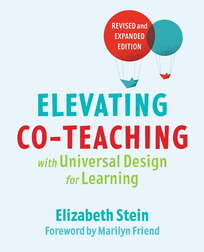I have found it helpful to set manageable goals, reflect on progress, and adjust along the way as needed. I select one or two goals early in the school year and document them in my Professional Growth Plan (PGP). When selecting goals, I consider the CAST UDL Guidelines and the areas in which I can adjust my practice to implement UDL more fully. Depending on the requirements of your organization’s PGP, documenting goals can make one consider how UDL implementation aligns with school or district improvement plans, what resources are needed, and the observable criteria to determine whether or not goals have been met. When a goal has been met, it could be replaced by a different goal, or one could choose to develop the goal more fully and set new criteria to increase proficiency within a given area.
As teachers learn to set goals, create and follow a plan to meet goals, and reflect on progress along the way, we can also intentionally design lessons that model and teach these skills to our students, and in doing so we are implementing practices that are based in the UDL Guidelines. Following is an example of how a single checkpoint in the UDL Guidelines (8.1 – Heighten salience of goals and objectives) can be used to guide the implementation of UDL in an elementary school classroom:
_______________________________________________________________________________
Sample goal and action plan - phase 1
Goal: Increase student awareness of curriculum outcomes by heightening the salience of goals and objectives throughout instruction (CAST UDL Guidelines – checkpoint 8.1)
Action plan:
- Display learning goals in student-friendly language and refer to them often
- Discuss goals with students in whole class, small group, and individual contexts and document student progress
- Offer opportunities for students to reflect on progress toward meeting goals
Resources needed:
- Time to collaborate with grade level team to develop bank of goals written in student-friendly language in all subject areas
- Area in classroom to display learning goals in student-friendly language
- Template for conferring notes to document student progress
Evidence of achievement:
- Learning goals in student-friendly language are visible in the classroom
- Students can locate and explain posted goals
- Students can discuss personal goals and reflect on their progress
- Conferring notes reflect discussions with students about progress and next steps
Reflecting on progress toward meeting a goal is an ongoing process. Upon having met this goal, new goals could be added to continue to develop this checkpoint if desired. In addition to continuing the practice of displaying learning goals in the classroom in student-friendly language, one could further engage students by having them state the goals aloud at the beginning of the lesson. This can be executed in different ways. In my elementary classroom it is a class job and students take turns to be the “goal reader” each day. One could further heighten the salience of goals and objectives throughout a lesson by having goals visible on activities and assessments. We can also intentionally create opportunities for students to reflect on their progress toward meeting goals (with questions designed to encourage student reflection for guided discussions, interviews, and exit slips). Following is an example of a possible next phase of implementing this checkpoint:
_______________________________________________________________________________
Sample goal and action plan - phase 2
Goal: Continue to increase student awareness of curriculum outcomes by heightening the salience of goals and objectives throughout instruction (CAST UDL Guidelines – checkpoint 8.1)
Action plan:
- Display learning goals in student-friendly language and have students refer to it often
- Display learning goals in student-friendly language on activities and assessments
- Offer opportunities for students to reflect on progress toward meeting goals through the use of guiding questions/prompts (i.e. pair and share, exit slips, interviews)
Resources needed:
- Area in classroom to display learning goals in student-friendly language
- Time to edit documents (activities, assessments) to include learning goals
- Time to collaborate with colleagues to create a bank of questions/prompts that guide student reflection toward meeting goals in a variety of contexts
Evidence of achievement:
- Learning goals in student-friendly language are visible in the classroom. Students can locate and read the goal at the beginning of a lesson
- Learning goals are visible on activities and assessments
- Students discuss progress toward meeting goals with teacher and peers, and record written reflections on exit slips
- Guiding questions/ prompts are in use
One could continue to dive deeper into this checkpoint. Other practices that can heighten the salience of goals and objectives throughout instruction may include but are not limited to, teaching students to formulate goals, how to break down larger goals into smaller goals, involving students in co-constructing criteria for assignments, presenting rubrics to students before completing work so they are made aware of the expectations in advance, or involving students in the creation of rubrics. One could opt to tackle this checkpoint in its entirety or move onto another area of interest and return to this one when ready to develop it more fully. It really depends on the interests of each educator and their desired approach to implementing UDL.


